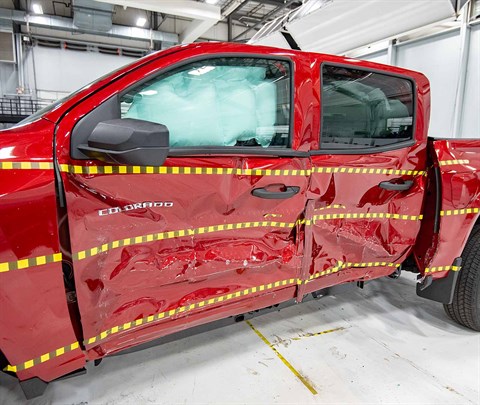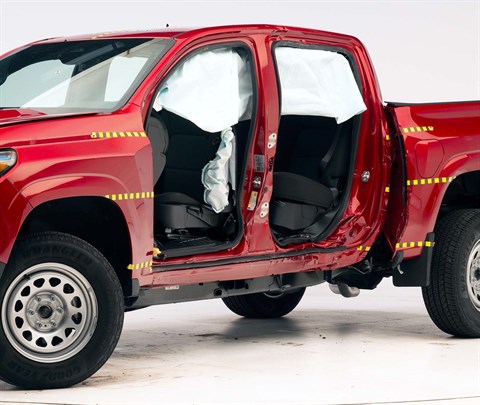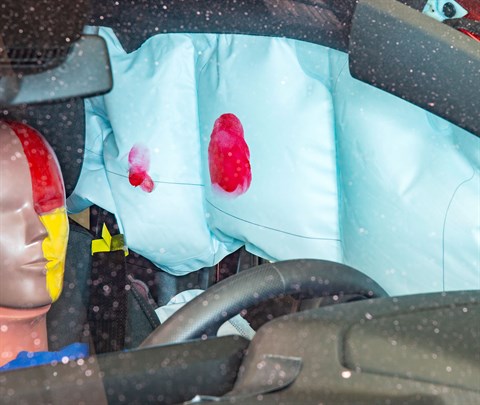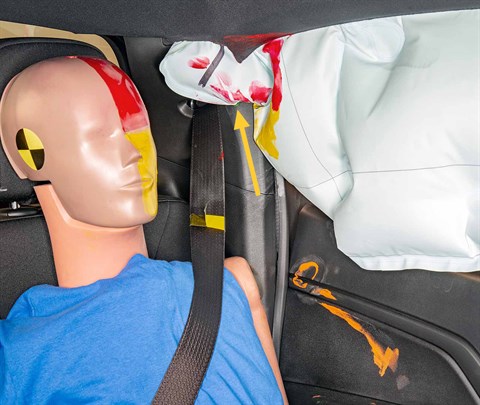Small overlap front
The small overlap front evaluation consists of a driver-side and a passenger-side component. If the results of the two evaluations differ, then the combined small overlap rating is equal to the lower rating.
Driver-side
Tested vehicle: 2023 GMC Canyon AT4 crew cab 4wd
Rating applies to 2023-25 models
The Chevrolet Colorado and GMC Canyon were redesigned for the 2023 model year. Driver-side small overlap frontal ratings are assigned by the Institute based on a test of a 2023 Canyon conducted by General Motors.
| Evaluation criteria | Rating |
|---|---|
| Overall driver-side evaluation | |
| Structure and safety cage | |
| Driver injury measures | |
| Head/neck | |
| Chest | |
| Hip/thigh | |
| Lower leg/foot | |
| Driver restraints and dummy kinematics | |
Measures of occupant compartment intrusion on driver side
| Evaluation criteria | Measurement |
|---|---|
| Test ID | VTN2504 |
| Lower occupant compartment | |
| Lower hinge pillar max (cm) | 9 |
| Footrest (cm) | 13 |
| Left toepan (cm) | 9 |
| Brake pedal (cm) | 10 |
| Parking brake (cm) | |
| Rocker panel lateral average (cm) | 0 |
| Upper occupant compartment | |
| Steering column | 1 |
| Upper hinge pillar max (cm) | 7 |
| Upper dash (cm) | 6 |
| Lower instrument panel (cm) | 5 |
Driver injury measures
| Evaluation criteria | Measurement |
|---|---|
| Test ID | VTN2504 |
| Head | |
| HIC-15 | 99 |
| Peak gs at hard contact | no contact |
| Neck | |
| Tension (kN) | 1.1 |
| Extension bending moment (Nm) | 7 |
| Maximum Nij | 0.22 |
| Chest maximum compression (mm) | 27 |
| Femur (kN) | |
| Left | 1.9 |
| Right | 0.4 |
| Knee displacement (mm) | |
| Left | 3 |
| Right | 1 |
| Knee-thigh-hip injury risk (%) | |
| Left | 0 |
| Right | 0 |
| Maximum tibia index | |
| Left | 0.59 |
| Right | 0.41 |
| Tibia axial force (kN) | |
| Left | 2.0 |
| Right | 1.8 |
| Foot acceleration (g) | |
| Left | 64 |
| Right | 72 |
Passenger-side
Tested vehicle: 2023 GMC Canyon Elevation crew cab 4wd
Rating applies to 2023-25 models
The Chevrolet Colorado and GMC Canyon were redesigned for the 2023 model year. Passenger-side small overlap frontal ratings are assigned by the Institute based on a test of a 2023 Canyon conducted by General Motors.
| Evaluation criteria | Rating |
|---|---|
| Overall passenger-side evaluation | |
| Structure and safety cage | |
| Passenger injury measures | |
| Head/neck | |
| Chest | |
| Hip/thigh | |
| Lower leg/foot | |
| Passenger restraints and dummy kinematics | |
| Driver injury measures | |
| Head/neck | |
| Chest | |
| Hip/thigh | |
| Lower leg/foot | |
| Driver restraints and dummy kinematics | |
Measures of occupant compartment intrusion on passenger side
| Evaluation criteria | Measurement |
|---|---|
| Test ID | VTP2504 |
| Lower occupant compartment | |
| Lower hinge pillar max (cm) | 8 |
| Footrest (cm) | 17 |
| Right toepan (cm) | 14 |
| Center toepan (cm) | 9 |
| Rocker panel lateral average (cm) | 0 |
| Upper occupant compartment | |
| Center dash (cm) | 6 |
| Upper hinge pillar max (cm) | 7 |
| Upper dash (cm) | 8 |
| Right lower dash (cm) | 9 |
Passenger injury measures
| Evaluation criteria | Measurement |
|---|---|
| Test ID | VTP2504 |
| Head | |
| HIC-15 | 81 |
| Peak gs at hard contact | no contact |
| Neck | |
| Tension (kN) | 1.2 |
| Extension bending moment (Nm) | 16 |
| Maximum Nij | 0.26 |
| Chest maximum compression (mm) | 26 |
| Femur (kN) | |
| Left | 1.8 |
| Right | 2.1 |
| Knee displacement (mm) | |
| Left | 7 |
| Right | 7 |
| Knee-thigh-hip injury risk (%) | |
| Left | 0 |
| Right | 0 |
| Maximum tibia index | |
| Left | 0.83 |
| Right | 0.76 |
| Tibia axial force (kN) | |
| Left | 3.8 |
| Right | 5.6 |
| Foot acceleration (g) | |
| Left | 69 |
| Right | 117 |
Driver injury measures
| Evaluation criteria | Measurement |
|---|---|
| Test ID | VTP2504 |
| Head | |
| HIC-15 | 52 |
| Peak gs at hard contact | no contact |
| Neck | |
| Tension (kN) | 0.6 |
| Extension bending moment (Nm) | 5 |
| Maximum Nij | 0.14 |
| Chest maximum compression (mm) | 25 |
| Femur (kN) | |
| Left | 0.1 |
| Right | 0.0 |
| Knee displacement (mm) | |
| Left | 0 |
| Right | 0 |
| Knee-thigh-hip injury risk (%) | |
| Left | 0 |
| Right | 0 |
| Maximum tibia index | |
| Left | 0.23 |
| Right | 0.17 |
| Tibia axial force (kN) | |
| Left | 0.7 |
| Right | 0.6 |
| Foot acceleration (g) | |
| Left | 19 |
| Right | 37 |
Side: updated test
Tested vehicle: 2025 Chevrolet Colorado WT Crew Cab 4-door 4wd
Rating applies to 2023-25 models
The Chevrolet Colorado and GMC Canyon were redesigned for the 2023 model year.
| Evaluation criteria | Rating |
|---|---|
| Overall evaluation | |
| Structure and safety cage | |
| Driver injury measures | |
| Head/neck | |
| Torso | |
| Pelvis | |
| Driver head protection | |
| Rear passenger injury measures | |
| Head/neck | |
| Torso | |
| Pelvis | |
|
Rear passenger head protection
| |

View of the vehicle just after the crash test.

View of the vehicle after the crash with doors removed, showing the side airbags and damage to the occupant compartment.

Smeared greasepaint shows where the driver dummy's head was protected from being hit by hard structures by the side airbags.

Smeared greasepaint shows where the rear passenger dummy's head struck the C-pillar.
Measures of occupant compartment intrusion on driver side
| Evaluation criteria | Measurement |
|---|---|
| Test ID | CES2502 |
| B-pillar to longitudinal centerline of driver's seat (cm) | -17.0 |
| Negative numbers indicate the amount by which the crush stopped short of the seat centerline. | |
Driver injury measures
| Evaluation criteria | Measurement |
|---|---|
| Test ID | CES2502 |
| Head | |
| HIC-15 | 55 |
| Peak gs at hard contact | no contact |
| Neck | |
| Tension (kN) | 0.8 |
| Compression (kN) | 0.3 |
| Shoulder | |
| Lateral deflection (mm) | 16 |
| Lateral force (kN) | 1.0 |
| Torso | |
| Maximum deflection (mm) | 20 |
| Average deflection (mm) | 18 |
| Maximum deflection rate (m/s) | 4.04 |
| Maximum viscous criterion (m/s) | 0.37 |
| Pelvis | |
| Combined force (kN) | 2.9 |
Passenger injury measures
| Evaluation criteria | Measurement |
|---|---|
| Test ID | CES2502 |
| Head | |
| HIC-15 | 136 |
| Peak gs at hard contact | |
| Neck | |
| Tension (kN) | 0.1 |
| Compression (kN) | 1.0 |
| Shoulder | |
| Lateral deflection (mm) | 26 |
| Lateral force (kN) | 0.9 |
| Torso | |
| Maximum deflection (mm) | 18 |
| Average deflection (mm) | 14 |
| Maximum deflection rate (m/s) | 1.47 |
| Maximum viscous criterion (m/s) | 0.09 |
| Pelvis | |
| Combined force (kN) | 1.9 |
Headlights
Trim level(s): All trims
| Evaluation criteria | Rating |
|---|---|
| Low-beam headlight type | LED projector |
| High-beam headlight type | LED projector |
| Curve-adaptive? | No |
| High-beam assist? | Yes |
|
Overall rating | |
| Distance at which headlights provide at least 5 lux illumination: | |
Low beams
On the straightaway, visibility was good on both sides of the road. On curves, visibility was good on the gradual right curve and fair on the sharp right and both left curves.
The low beams never exceeded glare limits.
High beams
On the straightaway, visibility was good on both sides of the road. On curves, visibility was fair on the gradual right curve and inadequate on the sharp right and both left curves.
High-beam assist compensates for some limitations of this vehicle's low beams on the straightaway, on both left curves and on the gradual right curve.
| Evaluation criteria | Measurement |
|---|---|
| Trim level(s) |
|
| Low-beam headlight type | LED projector |
| High-beam headlight type | LED projector |
| Curve-adaptive? | No |
| High-beam assist? | Yes |
|
Overall rating Applies to 2025 models |
| LOW BEAMS | Average minimum useful illumination distance (5 lux) |
Amount glare exceeded threshold |
|---|---|---|
| Straightaway right edge | 95.4 m | None |
| Straightaway left edge | 57.5 m | None |
| 250m radius right curve, right edge | 65.7 m | None |
| 250m radius left curve, left edge | 59.1 m | None |
| 150m radius right curve, right edge | 50.9 m | None |
| 150m radius left curve, left edge | 47.7 m | None |
| HIGH BEAMS | Average minimum useful illumination distance (5 lux) |
|---|---|
| Straightaway right edge | 158.6 m |
| Straightaway left edge | 143.3 m |
| 250m radius right curve, right edge | 66.6 m |
| 250m radius left curve, left edge | 64.1 m |
| 150m radius right curve, right edge | 50.1 m |
| 150m radius left curve, left edge | 48.5 m |